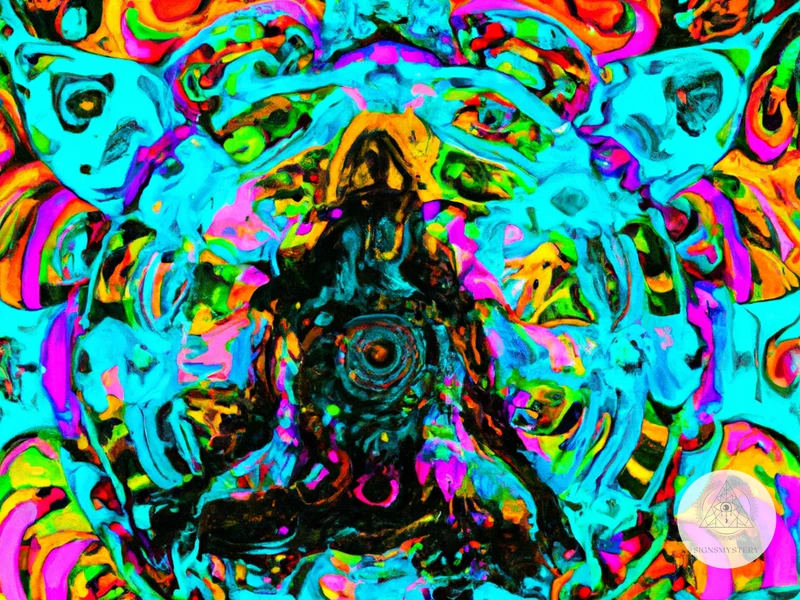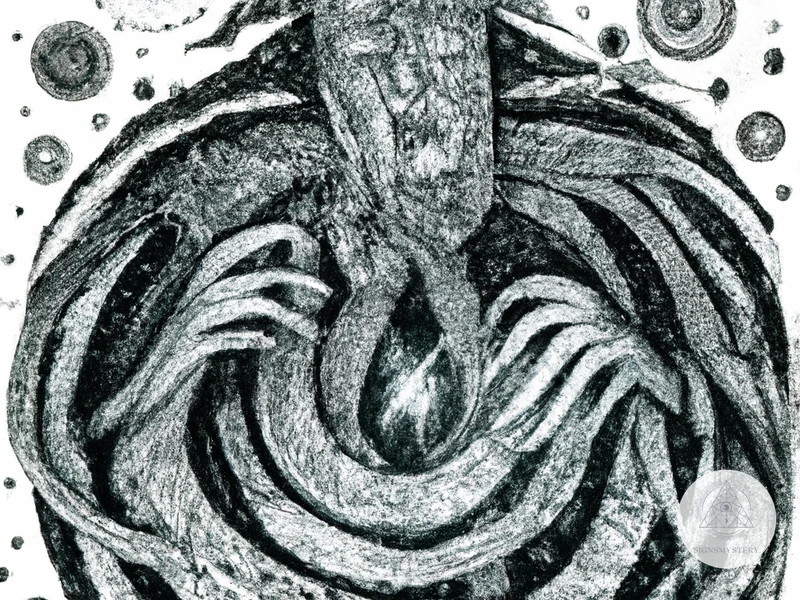Have you ever wondered about the mystical practice of shamanism and its connection to the unconscious mind? Shamanism is an ancient spiritual practice that involves interacting with the spirit world to receive insights, guidance, and healing. The unconscious mind, on the other hand, is a complex and mysterious part of our psyche that plays a crucial role in shaping our thoughts, emotions, and behavior. But how do these two seemingly unrelated concepts intersect? In this exploration of shamanism and the unconscious mind, we’ll delve into the history and beliefs of shamanism, examine the nature of the unconscious mind, and explore the ways in which shamanism provides a doorway into this hidden realm of the psyche.
What is Shamanism?

Shamanism is a set of spiritual practices that have been used for thousands of years by indigenous cultures all around the world. It involves connecting with the spirit world through altered states of consciousness to gain wisdom, guidance, and healing. Shamanism is often associated with the use of shamanic journeying, which is a method of inducing a trance-like state to access the spiritual realm.
Shamanism is a holistic practice that sees everything as interconnected and considers the well-being of the entire community, including nature and the environment. Shamans are the spiritual leaders or healers in their communities and are believed to have the ability to communicate with the spirit world to bring healing to individuals, the community, and the world.
The core of shamanism revolves around the belief that everything has a spirit and that spirits have the power to influence our lives. Shamans are known to use various tools such as drums, rattles, and plant medicines to enter altered states of consciousness to communicate with these spirits.
History of Shamanism
Shamanism is an ancient practice that has been present all over the world for many thousands of years. It is believed to have originated in Siberia over 20,000 years ago and spread from there throughout the world. Shamanic practices have been found in many cultures from Native American tribes to Australian Aboriginal groups. In shamanic cultures, the shaman is a healer who has the ability to communicate with spirits and enter altered states of consciousness to gain knowledge. They use techniques such as drumming, chanting, and dancing to enter these states. Shamans also have a close connection to nature and often use plants to enhance their abilities. Understanding the history of shamanism is important in recognizing its significance for healing and spiritual growth today.
Shamanic Beliefs and Practices
Shamanism is a spiritual practice that connects individuals with the spirit world. In shamanic beliefs, the world is inhabited by both seen and unseen spirits that can influence human life. Shamanic practitioners believe that they can communicate with these spirits through meditation, rituals, and ceremonies. These spiritual practices typically involve the use of music, dance, and natural hallucinogens to enter trance states. Here are some key beliefs and practices of shamanism:
| Beliefs | Practices |
|---|---|
|
|
Shamans use these practices not only for spiritual growth but also for healing purposes. Shamans believe that illness can be caused by spiritual imbalances and that by reconnecting with the spirit world they can regain balance and promote healing. For example, shamanic healing has been used to treat trauma and PTSD, addiction, grief and loss, and inner child healing. By aligning with the spirit world, individuals can form a deeper understanding of themselves and the world around them which can bring transformative personal growth.
If you are interested in learning more about how shamanic practices can be applied in psychotherapy, check out our article on Working with Spirit Guides in Shamanic Psychotherapy. You can also learn more about shamanic practices for healing from our articles on Shamanic Healing of Trauma and PTSD, Shamanic Practices for Addiction Recovery, and Shamanism and Inner Child Healing. If you are interested in the significance of dreams in shamanism, check out our article on The Significance of Dreams in Shamanic Practices. Finally, if you are interested in learning more about the intersection between shamanism and transpersonal psychology, check out our overview article on Transpersonal Psychology and Shamanism.
Shamanism and Spirituality
Shamanism is deeply intertwined with spirituality, as the practice involves connecting with spirits and the unseen world. The goal of shamanism is not only to heal an individual, but to also establish and maintain harmony and balance between individuals, the natural world, and the spiritual world.
Many shamans believe that everything in the world is connected by a spiritual force, and that sickness or disease can be caused by an imbalance of this force. To restore balance, a shaman may perform various ceremonies and rituals, such as purification rituals, offerings, and divination.
Shamanism is not tied to any specific religious doctrine or dogma. It is often described as a way of life or a spiritual practice rather than a religion. Shamans may incorporate various spiritual beliefs, practices, and traditions into their work, depending on the culture and region they come from.
For example, in some cultures, shamans may work with ancestral spirits or the spirits of nature. In other cultures, shamanism is closely connected to a particular deity or pantheon of deities. Regardless of these differences, the overall goal of shamanism remains the same: to connect with the spiritual world and bring healing and balance to the physical world.
One aspect of shamanic spirituality is the recognition and acceptance of death as a natural part of the cycle of life. In many shamanic traditions, death is seen as a transition to another phase of existence, rather than an end.
Shamanic grief and loss is a term used to describe the process of mourning and healing in shamanic cultures. It involves working with the spirits of the deceased and honoring their memory, as well as using shamanic practices to support healing and growth for the living.
Shamanism and spirituality are intimately connected, with the goal of shamanism being to establish and maintain harmony and balance between individuals, the natural world, and the spiritual world. Shamans may incorporate various spiritual beliefs, practices, and traditions into their work, but the overall goal remains the same.
The Unconscious Mind
The unconscious mind refers to the part of our mental processes that we are not actively aware of, yet still influence our thoughts, behaviors, and emotions. It includes automatic bodily functions like breathing and heart rate, as well as deeper levels of awareness such as primordial instincts and repressed memories. The concept of the unconscious was first introduced by Sigmund Freud and is a fundamental tenet of his psychoanalytic theory.
Freud believed that the unconscious was primarily composed of repressed sexual and aggressive desires from childhood experiences. He developed the technique of psychoanalysis to bring these repressed experiences into consciousness in order to alleviate psychological distress. In contrast, Carl Jung believed that the unconscious contains not only repressed experiences but also a collective unconscious that holds universal archetypes and symbols that are shared across all cultures.
The collective unconscious is a concept introduced by Jung, which describes the shared psychological inheritance of all humans. According to this theory, the collective unconscious is a store of ancestral memories and experiences that have been passed down from generation to generation. This means that we are all connected to a deeper, universal level of consciousness that goes beyond our individual experiences.
To illustrate this, Jung used the example of the “shadow,” which represents the darker aspects of our unconscious that we deny or repress. While the contents of each person’s shadow are unique, the concept of the shadow itself is universal and can be found in the collective unconscious.
Understanding the workings of the unconscious mind can provide a deeper understanding of ourselves and our behaviors. It can also be a powerful tool for personal growth and healing, particularly when used in conjunction with practices such as shamanism. To learn more about shamanic approaches to grief and loss, check out our guide on Shamanic Grief and Loss.
Definition and Explanation
The unconscious mind is a fascinating and complex topic that has captured the attention of many throughout history. It refers to that part of the mind that is not within our conscious awareness. Instead, it consists of thoughts, feelings, and memories that are outside of our current awareness but can still influence our behavior and experiences. There are different views on the nature of the unconscious mind, with Freudian and Jungian perspectives being the most well-known. While Freud believed that the unconscious was primarily composed of repressed desires and memories related to early childhood experiences, Jung saw it as a reservoir of collective knowledge and wisdom. Ultimately, understanding the concept of the unconscious mind is crucial to understanding ourselves and our behavior.
Freudian vs Jungian Views
When it comes to understanding the unconscious mind, two influential figures in psychology were Sigmund Freud and Carl Jung. While both shared similar ideas regarding the unconscious mind, there were also significant differences in their views.
Freud believed that the unconscious mind was a repository of repressed desires and thoughts, mostly related to our instinctual drives for sex and aggression. He saw dreams as a gateway to the unconscious, a way for repressed thoughts and desires to emerge and be processed. He also developed psychoanalysis as a way to explore and understand the unconscious through talk therapy.
Jung, on the other hand, viewed the unconscious as a vast, complex system that included both personal and collective elements. He believed that the unconscious contained not only repressed desires, but also a store of universal archetypes that were shared by all humans, including the shadow, the anima/animus, and the self. He saw dreams and other symbolic expressions as a way to connect with these archetypes and bring them to consciousness.
Here is a table summarizing some of the key similarities and differences between Freudian and Jungian views of the unconscious mind:
| Freud | Jung |
|---|---|
| View of the unconscious: repository of repressed desires and thoughts | View of the unconscious: vast, complex system with personal and collective elements |
| Role of dreams: gateway to the unconscious, processing repressed desires and thoughts | Role of dreams: connection to universal archetypes, bringing them to consciousness |
| Focus of psychoanalysis: exploring and understanding the unconscious through talk therapy | Focus of analysis: exploring the personal and collective unconscious through symbols and archetypes |
While both Freud and Jung emphasized the importance of the unconscious mind in shaping our thoughts, feelings, and behaviors, they had different views on what exactly the unconscious was and how it could be accessed and understood. Understanding these different perspectives can help us appreciate the complexity of the unconscious and the various methods that can be used to explore it.
Collective Unconscious
Collective Unconscious
The concept of collective unconscious is closely related to the works of Carl Jung, one of the pioneers of modern psychology. According to Jung, the collective unconscious is a part of the psyche that contains the shared evolutionary experiences of humankind. Unlike the personal unconscious, which contains an individual’s repressed thoughts and experiences, the collective unconscious is universal and holds archetypal patterns and symbols that are common across all cultures.
Jung believed that the collective unconscious manifests itself in myths, religions, and cultural symbols. It is through these shared images that we can connect with each other on a deeper level and tap into the wisdom of the ages. It is also believed that the collective unconscious influences our behavior, emotions, and beliefs without us even realizing it.
The idea of the collective unconscious can be seen in many shamanic practices. Shamanic rituals often involve the use of symbols, such as animals or natural elements, that represent archetypes found in the collective unconscious. By tapping into these archetypes, the shaman can help individuals connect with their inner selves and the collective wisdom of the human experience.
One example of the collective unconscious in shamanism is the idea of the world tree. The world tree is a symbol found in many cultures and religions, and it represents the connection between the physical and spiritual worlds. In shamanic practice, the world tree can be used as a tool for journeying into the spiritual realm and accessing the knowledge and wisdom of the collective unconscious.
The concept of the collective unconscious can be perplexing, as it requires us to believe in a shared experience that is not based on physical evidence. However, it is through this shared experience that we can connect with each other and with the deeper aspects of ourselves. By understanding the collective unconscious and the role it plays in shamanic practice, we can gain a greater appreciation for the power of symbols and archetypes and the ways in which they can help us heal and grow.
Shamanism and the Unconscious

Shamanism and the Unconscious are interconnected in multiple ways. Understanding the connection between the two can help us to comprehend the shamanic practices and their beliefs. Here are some of the ways in which Shamanism relates to the Unconscious Mind:
Shamanism uses various techniques to create altered states of consciousness that allow the shaman to communicate with the spirit world. Altered states can be induced by drumming, chanting, fasting, or the use of psychoactive plants. These states of consciousness allow the shaman to access parts of the mind that are not accessible during ordinary waking consciousness, including the Unconscious Mind.
Dreams and visions are an essential part of many shamanic traditions. Dreams are considered to be a gateway between the conscious and the Unconscious Mind, while visions are often seen as messages from the spirit world. Shamans often use their dreams and visions to gain insight into specific situations and to communicate with spirits.
Shamanic practices can help access and work with Unconscious contents. The shaman acts as a mediator between the client and their Unconscious Mind, helping them to access hidden aspects of themselves. Through shamanic practices such as soul retrieval or shadow work, the shaman can guide the client in exploring their Unconscious.
Shamanic practices can also help to bring repressed emotions and memories from the Unconscious to the conscious level. This can help the client to process and integrate them, leading to personal growth and transformation.
Shamanic practices have many benefits, including personal growth, healing, and expansion of consciousness. The next part of the article will explore the benefits of understanding the connection between Shamanism and the Unconscious.
Shamanism’s Use of Altered States
Shamanism is known for its use of altered states to connect with the spiritual realm. This is often done through various practices, such as meditation, chanting, drumming, and the use of plant medicines. These altered states allow the shaman to enter a trance-like state, where they can interact with spirits and receive guidance. The use of altered states is not limited to shamanism, as it has been observed in many cultures throughout history, from ancient Greece to modern-day rave culture. However, shamanism places a great emphasis on the importance of these altered states, believing that they offer a gateway to the unconscious mind and the spiritual realm that cannot be accessed in a normal waking state. This allows the shaman to gain insight and understanding that can be used for healing, personal growth, and spiritual connection.
The Role of Dreams and Visions
In Shamanism, dreams and visions are seen as important tools for accessing the unconscious mind and communicating with spirits and other entities. Through these altered states of consciousness, shamans can gain insights and guidance on personal and spiritual matters.
One common method used by shamans to induce visions and dreams is through the use of dreamcatchers. These are intricate webs of natural materials, such as feathers and beads, that are hung near a person’s bed to capture bad dreams and allow good dreams to pass through. The idea is that the dreamcatcher acts as a filter, sifting out negative energy and thoughts, while allowing positive energy to flow freely.
Another technique used in Shamanism is the practice of journeying, which involves entering into a trance-like state to explore the unconscious mind. During a journey, a shaman may use repetitive drumming, chanting, or other methods to induce an altered state of consciousness. Once in this state, they can communicate with spirits and other entities, gaining knowledge and insight into their own psyche and the world around them.
Visions and
Subscribe to Our Newsletter
Sign up to receive the latest news and updates.
It’s important to note that not all dreams and visions are interpreted literally in Shamanism. Instead, they are often viewed as metaphorical or symbolic representations of a deeper truth. This is why interpretation is such an important part of the shamanic journey, as it enables a person to unravel the hidden meanings behind their experiences in the altered state.
The role of dreams and visions in Shamanism is a vital one. They are seen as gateways to the unconscious mind, providing access to hidden knowledge and insights that can help a person grow spiritually and emotionally. By exploring these altered states of consciousness, a shaman can gain a deeper understanding of themselves and the world around them, leading to a more fulfilling and purposeful life.
Shamanism as a Way to Access Unconscious Content
Shamanism has been used for centuries as a way to access unconscious content, helping individuals gain a deeper understanding of themselves and the world around them. This spiritual practice involves the use of altered states of consciousness to connect with the spiritual realm and receive guidance.
Shamanic Journeying is one of the methods used in shamanism to access the unconscious. A shamanic journey involves entering a trance state through drumming, meditation, or the use of entheogenic plants. Once in this altered state, the shaman can travel to the spiritual realm and communicate with their spirit guides. These guides can offer insight and guidance on personal and spiritual matters, as well as help the individual address issues in their unconscious mind.
Ayahuasca is another method used in shamanism to access unconscious content. This plant medicine is often used in South American shamanic traditions and has been known to induce intense visionary experiences. Ayahuasca has been shown to help individuals process past traumas, confront unresolved emotions, and gain a deeper understanding of themselves and their place in the world.
Dreamwork is also a powerful tool used in shamanism to access unconscious content. The shamanic practitioner can interpret their own dreams or facilitate dreamwork for others to gain insight into their unconscious mind. Dreams can provide valuable symbolic messages and guidance that can help individuals on their personal and spiritual journey.
Animal guides are another way that shamanism accesses unconscious content. Shamans believe that every individual has an animal guide or totem that represents their inner qualities and aspects of their unconscious mind. These animal guides can be called upon for guidance, support, and protection.
Shamanism provides a powerful way to access unconscious content through the use of altered states of consciousness, plant medicine, dreamwork, and animal guides. By connecting with the spiritual realm, individuals can gain a deeper understanding of themselves and the world around them, leading to personal growth and spiritual development.
Benefits of Understanding the Connection
Understanding the connection between shamanism and the unconscious mind can have numerous benefits for personal growth, spiritual development, and healing. Below are some of the most significant benefits that can come from this understanding.
Learning about shamanism and the unconscious mind can lead to significant healing and personal growth. This is because shamanic practices often involve accessing the unconscious mind and working with it to release emotional blockages and traumas that may be preventing a person from living a fulfilling life. By doing so, individuals can experience an increased sense of emotional freedom, mental clarity, and personal empowerment.
Another benefit of understanding the connection between shamanism and the unconscious mind is an expansion of consciousness. Shamanic practices often involve entering altered states of consciousness, which can provide individuals with new perspectives and insights into their lives. This expanded consciousness can help people see beyond the limitations of their current beliefs and behaviors, leading to personal growth and transformation.
Shamanism and the unconscious mind can also help people develop a deeper spiritual connection. By accessing the unconscious mind, individuals may be able to tap into a collective consciousness that exists beyond their individual existence. This can lead to a sense of interconnectedness with the universe and all living beings, providing individuals with a greater sense of purpose, meaning, and spiritual fulfillment.
Understanding the connection between shamanism and the unconscious mind can lead to a wide range of benefits, from healing and personal growth to expanded consciousness and deeper spiritual connection. By learning about and integrating shamanic practices into their lives, individuals may be able to unlock their full potential and live a more fulfilling life.
Healing and Personal Growth
When exploring the connection between Shamanism and the unconscious mind, one of the most notable benefits is the potential for healing and personal growth. By accessing and understanding the depths of the unconscious, a person can confront and overcome emotional or psychological challenges that may be hindering their progress in life. Shamanism can help individuals connect with their inner selves to discover underlying issues and patterns. Through this process, individuals can experience profound healing and find deeper meaning in their lives. Shamanic practices can provide insights and give people a renewed sense of purpose. Ultimately, understanding the connection between Shamanism and the unconscious mind can lead to transformative personal growth and positive change.
Expansion of Consciousness
Understanding the connection between shamanism and the unconscious mind can lead to an expansion of consciousness, which can be a transformative experience. This expansion of consciousness comes from accessing and integrating unconscious material into our conscious selves, which can lead to a shift in perception and an opening up of new possibilities.
One way shamanism facilitates the expansion of consciousness is through the use of entheogens, or psychoactive substances that can produce altered states of consciousness. These substances have been used by shamans for thousands of years in various cultures around the world. While the use of entheogens is controversial, many people believe that they can be a powerful tool for expanding consciousness and accessing the unconscious mind.
Another way that shamanism can help with the expansion of consciousness is through journeying. Journeying is a meditative practice that uses drumming or other repetitive sounds to alter brain waves and induce a trance-like state. In this state, the shaman can travel to other realms and dimensions, encountering spirits and gaining insight into the nature of reality.
Through these practices, shamanism can help individuals access parts of their psyche that are not normally available to conscious awareness. This can lead to a deeper understanding of oneself and the world around us, and can help foster a sense of interconnectedness and unity with all things.
To further illustrate the expansion of consciousness that can come through shamanic practices, here are some examples of experiences that people have reported:
- Feeling a sense of oneness or unity with all things
- Experiencing a dissolution of ego boundaries
- Encountering a powerful spiritual presence or entity
- Feeling a profound sense of love and interconnectedness
- Receiving messages or guidance from the unconscious mind or spiritual entities
While not everyone who practices shamanism will experience these things, they are all possible outcomes of an expanded consciousness. The connection between shamanism and the unconscious mind offers a pathway for personal transformation, growth, and spiritual development.
Deeper Spiritual Connection
When exploring the connection between shamanism and the unconscious mind, it’s important to understand the deeper spiritual connection that can be achieved through these practices. Shamanism offers a unique perspective on spirituality that goes beyond organized religion and connects us directly with the Earth and all living beings. This can lead to a deeper understanding of the universe and our place in it.
One way that shamanism can deepen spiritual connections is through the use of plant medicines. These substances are believed to help unlock doors to other realms and dimensions, allowing us to connect with higher powers and spiritual beings. Ayahuasca, for example, is a powerful plant medicine used in shamanic practices that has become increasingly popular in the western world. It is known to produce intense spiritual experiences that can have deep and lasting effects on one’s spirituality.
Another way shamanism can deepen spiritual connections is through the use of ritual and ceremony. Shamanic ceremonies are often designed to honor the spirits of the natural world, and can involve offerings, drumming, chanting, and dance. These practices help us connect with the spiritual essence of the natural world and can help us feel a deeper connection to our environment.
Practicing shamanism can also lead to a deeper sense of interconnectedness with all living beings. Shamans view the world as one interconnected web of life, and through this lens, we can see the divine essence in all things. This can lead to a deeper sense of compassion, empathy, and understanding towards other people and towards nature.
Shamanism offers a unique and powerful way to connect with the spiritual world and our unconscious minds. Through the use of plant medicines, ritual and ceremony, and a deeper sense of interconnectedness, we can open up to new perspectives on our place in the universe and deepen our spiritual connections.
Conclusion
In conclusion, the connection between shamanism and the unconscious mind is a fascinating and complex topic that has many implications for our personal growth and spiritual development. By understanding the history and beliefs of shamanism and the nature of the unconscious mind, we can begin to appreciate the ways in which these two concepts intersect.
Shamanism offers us a unique perspective on the nature of reality and the role of consciousness in shaping our experiences. From its use of altered states to its emphasis on dreams and visions as sources of wisdom and insight, shamanism provides us with a powerful framework for exploring our inner world and uncovering hidden aspects of ourselves.
At the same time, the unconscious mind offers us an equally powerful tool for understanding our psychological and spiritual processes. By tapping into the wisdom of our dreams, exploring the depths of our psyche, and engaging with the collective unconscious, we can expand our awareness and gain new insights into the nature of reality.
Ultimately, the connection between shamanism and the unconscious mind offers us a powerful path towards healing, personal growth, and spiritual transformation. Whether we are seeking to overcome trauma, explore our deepest truths, or connect more fully with the divine, this connection can help us to unlock new levels of understanding and insight.
So if you are interested in exploring the connection between shamanism and the unconscious mind, I encourage you to dive deeper into these fascinating and complex topics. Whether you choose to learn from traditional shamans, engage in your own spiritual practices, or simply read more about these subjects, there is much to be gained from this exploration. So take the time to explore this realm of knowledge, and discover the many benefits that come with a deeper understanding of the connection between shamanism and the unconscious mind.
Frequently Asked Questions
What is the origin of shamanism?
Shamanism is believed to be one of the oldest spiritual practices in the world, with roots dating back tens of thousands of years to ancient Siberia.
What is the main goal of shamanism?
The main goal of shamanism is to connect with and work with spirits and energies in the natural world to promote healing, balance, and community well-being.
Can anyone become a shaman?
While some individuals may have a natural inclination or spiritual calling to become a shaman, in most traditional societies, becoming a shaman involves a great deal of training, initiation, and apprenticeship under a skilled mentor.
How does one access the unconscious mind?
There are many ways to access the unconscious mind, including through meditation, dreams, and other altered states of consciousness. Shamans often use drumming, chanting, and other rituals to enter into trance states and work with the unconscious.
What is the collective unconscious?
The collective unconscious is a term coined by Carl Jung to describe the shared universal experiences and symbols that are deeply ingrained in the human psyche and can be accessed through dreams, myths, and archetypes.
How does shamanism promote healing?
Shamanism promotes healing through a variety of methods, including working with plant medicine, energy healing, and addressing the spiritual and emotional root causes of illness.
Can shamanism be practiced in modern society?
Yes, shamanism can be practiced in modern society, and there are many individuals and communities who still practice traditional shamanic rituals and ceremonies. However, it is important to approach shamanic practices with respect and cultural sensitivity.
What are the benefits of connecting with the unconscious mind?
Connecting with the unconscious mind can lead to greater self-awareness, increased creativity, and a deeper sense of spiritual connection. It can also be a powerful tool for healing and personal growth.
Is shamanism a form of religion?
While shamanism is often associated with indigenous spiritual practices, it is not necessarily a form of organized religion. Shamanism can be seen as a set of techniques and practices for engaging with the spiritual world, rather than a specific belief system.
Can shamanism be used in conjunction with other spiritual or therapeutic practices?
Yes, shamanism can be complementary to other spiritual or therapeutic practices. Individuals may find that integrating shamanic techniques and perspectives into their existing practices can lead to deeper insights and transformation.










